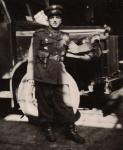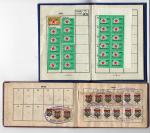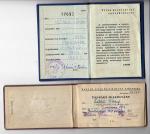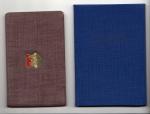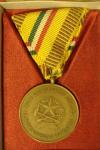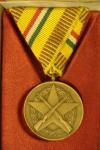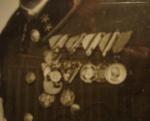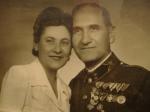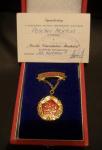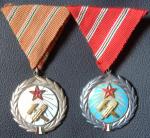-
Posts
2,660 -
Joined
-
Last visited
Content Type
Profiles
Forums
Blogs
Gallery
Events
Store
Everything posted by hunyadi
-
Its interesting to see the rings for the sword hanger - the only swords that I have ever heard of (and only once BTW) was that for pre 1956 General Dress Uniforms. However - for the River Flotilla the 1950 regulations showed a pistol beign hung from "dagger hangers" - but its also a different style belt - Not the Same Brown type. Do we have a photo of the sword in wear?
-
and the final icing to the cake - a photo of the shield badge in wear. Its not the greatest photo - but its what I have so far. Its the photo of (what I believe) to be an NCO - possibly a Sgt. cant make out the stars on the boards - on the tress. He is wearing a M1945 tunic (open collar four pocket tunic) of the artillery branch (crossed cannons on the collar). He is also wearing the "Tildy" style cap badge introduced in 1947. Above his upper right pocket it looks to be a partisan badge. The April 4th parade badges of the time (he could only be wearing a 1949 parade badge there) would be much smaller in size. Also by 1949 there was a new uniform in use, so I suspect that it is not an April 4th 1949 parade badge. Also - he is wearing a shield type Hungarian Freedom Fighters Badge. The scan did not bring it out - but looking at the original under a lupe you can make out some detail of the crossed torch and sword. The original photo is about 1.5" x 2.25" so its not big - but its more evidence.
-
And in my running around today I found this little gem to throw into the mix. It was in a Rakosi era box, the dealer had no idea what it was for - except that it was to the organization. Ribbon is interesting motiff. This one is similar to the type that I aquired last year. However my example (with the red ribbon) is 40mm in diameter and is "silver" in color. This particualr one is a pretty standard 35mm and is in bronze. Which now shows me at least that for the Second Party congress there were various grades to the medal that was handed out - but to whom and for what remains a mystery. I do not own the medal (but got permission for the photos) as the price was 100 X what I paid for my example... Me: "So what is this medal for? Who got it and why?" Dealer: "I dont know." Me: "So how much do you want for it?" Dealer: "Give me a $1000 for it....Its rare!"
-
Well - so far I have only heard from the one dealer that the smaller one is a cap badge - however - I have yet to see a photo of the uniform or a cap. (if they even existed at all) All that I have found is the 1948 regualtion that allowed the wear of the "badge" to be worn on the right upper pocket of the uniform. The regs do not give dimensions for the badge. It could be that the smaller badge may have been designed for civilain dress. At this point with all the evidence available I am saying that all of the larger badges (shield type and the wreath type with red star) are breast badges. The smaller one you have there may be a cap badge - might even be for a civilian to wear. By "early" I mean the shield type and by late I mean the wreath with star type. Confused yet?
-

Hungary Congratulations On the New Hungarian Section!
hunyadi replied to a topic in Central & Eastern European States
Good question - as I dont know what the criteria for the Order of Lenin or the Dimitrov is its hard for me to say. Taking a stab that I think those were given out for long periods of service and / or an exemplrary work at building the communist state - I would say the Order of Merit of the Hungarian People's Republic 1953 / 1957 model. This one was awarded only 13 times in 1953, 76 times between 1954 and 1957, 30 times between 1957 and 1978 and 21 times after 1978. There were no real state sponsored "personality" awards except for the Rakosi Student Medal (for good work in studies) but this was soon abolished when Rakosi fell out of favor. There was also the "Zalka Mate" medal - but this was given out to members of the communist party who fought in the Spanish Civil War. -

Hungary Congratulations On the New Hungarian Section!
hunyadi replied to a topic in Central & Eastern European States
Many thanks to all and to all of your hard work too! Our quest to know as much as we can about this period in Hungarian history can only be understod by the efforts of many - both Hisotrians, researchers, collectors and the few that we have here who actualy lived through it. I will be the first to admit that I dont know it all, and I make mistakes and wrong assumptions, but with the awesome community we have here, I am sure we can all work to the benefit of finding the answers and removing the shroud. Its an uphill battle and there is so much to learn and discover, but its a process that will be a fun ride for sure. By example - from 1945-1956 there were no less than five distinct changes to the uniforms, from 1948-1989 there were over 300 variants of the Excellent Worker Badge, from 1949 to 1956 there "Rakosi" national coat of arms that then canged after 1956 to the "Kaddar" coat of arms, several national sport organizatsions with ties to the military, etc. As I like to say now as one living through the period "If you dont like the look of the (uniform, badge, medal, buttons, etc...) just wait a few years comrade!" -
Though I cant post the photo - (Gordon you know where I got it from) I have this photo of an exact badge that has the sharp prongs on the back and a green felt backing. Also - on this badge it has the same style of more 'flat' torch / sword / wreath. Then there is the one I posted with no backing (but one could be easily added) and the prongs are more flat. So---- we have the early with a Type I (flat coat of arms and sharp priongs) and a Type II (more pronounced coat of arms and flat prongs) then we have the late type with sharp prongs and without sharp prongs...interesting for an association that was only around for a couple of years.
-

Bulgaria Hungarian LOOONG Service
hunyadi replied to hunyadi's topic in Central & Eastern European States
close up shot of the bar - sorry for the glare of the glass - its a nice photo and the silver is beginning to oxidize in the photo.- 3 replies
-
- Hungary
- Axis Powers
-
(and 1 more)
Tagged with:
-
Picked up this photo today. Its a huge size (8.5" x 11" aprox) in a frame. The dust and grime on it was an inch thick, but the price was very good. Cleaned it up and took at look at this 1st Lieutenant's Unifrom and Medal Bar. From the bar we have the Gold Merit Cross with Crown on War Ribbon, Silver Merit Cross, 1908 Jubilee Medal, WW1 Service Medal, 1940 Return of Transylvania medal, (unkonwn - sport?) WW1 Ausrtain Medal and finaly a WW1 Bulgarian Medal. Where in the world is his long service medal? And how in the world can one do such a good job at the GHQ (or some posting similar to that and only be a 1st Lieutenenat in 1940 after serving from at least 1908??) I cant see how he might have been an NCO that moved up through the ranks and gotten the Gold and Silver version of the Merit Cross? Perhaps someone wiht more understanding of the AH times could help me to understand. Though the photo is BW - I am guessing by the tone of the tabs he is Quartermaster or Medical.
- 3 replies
-
- Hungary
- Axis Powers
-
(and 1 more)
Tagged with:
-
The tunic is for a Capt (gold stars) if it was a Col it would have silver stars. Also just FYI of everyone - what makes this a late 1950's - late 1960's is the white liner to the sleves. They had this practice of the white "striped" silk liners for the sleeves way back to WW2 - continued it up till the 1960's. From 1957 to 1963 this open collar type of uniform was used as a parade dress uniform. Even after the 1956 revolution the service uniforms remained to have the closed collar with the 5 sided collar tabs. But these parade dress uniforms showed the Hungarian nation that - of all things - the image of the civilian service and the military "we have returned not to the WW2 / WW1 era, and not back to the Rakosi / Soviet era - but have reverted back to the Hungarian Republic of 1945-1949 era" (!!!) In 1963 this parade tunic was also then desingated as the serivce / work tunic. (to save on material and costs) Sadly after 1957 they quit putting state maker stamps on these - so its only a rougn guess of the period when it would have been worn.
-

Hungary Hungarian Kivalo Dolgozol Badges
hunyadi replied to hunyadi's topic in Central & Eastern European States
Another museum? Thankfuly we both have the best wives in the world. Yes - lets go! As for today - you left a little too early. Found the guy with the medals and he had this one for a little more than the price of dirt. Keeping with the railroad theme - this is an "Excellent Social Worker" for a guy with GANZ-M?VAG (they built locomotives, engines, bridges, etc...) M?VAG (Magyar ?llamvasutak G?pgy?ra - Hungarian State Railroads' Machine Factory) Originaly started as a steam locomotive company in 1873 it was one of the largest factories in Budapest. The other company GANZ - that made diesel engines was just down the road. They joined in 1959. Its an interesting badge - not a common type and it came with a ocument for 1982. What is also interesting is that the case is a hinged and latch type, but that it is also an early type scuff pad (marble design) with a late 1970's - 80's plastic faux lined blue injection molded insert. The insert is even a little small inside the case as this insert was clearly designed to go into a platsic type case. But this case was one of a few that pop up every now and then that were clearly made from the 1950's and forgotten until later when they were finised with the inserts (plastic type) Just another variant of 300+ "Kivalo" designs. -
Combat Medic Badge? Sadly its in storage, but I do remember looking it over very thoroughly when I got it - hopeing that there was some holes for wings or something, but nothing. So I think he was a regular flight mechanic , or as someone suggested a guy who flew with the general staff and delivered in flight tea, but didnt qualify for wings. But somehow he got that Air Medal. So - what did you find for me? Hero of the Hungarian People's Republic?
-

Hungary Hungarian People's Republic Awards
hunyadi replied to Ed_Haynes's topic in Central & Eastern European States
Hey Dan - I am going to guess that these are heavily gold plated - but so are the late 1950's - but you can clearly see that the "gold" on the latter version is just not as pronounced as this one - its night and day when it comes to the quality and the detail. -

Hungary Hungarian People's Republic Awards
hunyadi replied to Ed_Haynes's topic in Central & Eastern European States
Also the interesting part of this is the box that it came in. The box is a nice leatherette style and bears the Rakosi Coat of Arms on it. But the case is longer - more longer than I have ever seen before. Normaly the case this medal came in would be about 70mm wide and 115mm long. This one is 70mm wide and 135 mm long. Nice big coat of arms to boot! -

Hungary Hungarian People's Republic Awards
hunyadi replied to Ed_Haynes's topic in Central & Eastern European States
-

Hungary Hungarian People's Republic Awards
hunyadi replied to Ed_Haynes's topic in Central & Eastern European States
This little one came my way reently and its a very interesting early award. It is just a simple Labor Merit Medal (type II) insituted in 1954. (Type I was similar in design but was a solid piece of tombak - not enameled or as nice) Between 1954 and 1956 the Type II was awarded: 1954- 3964 times, 1955 - 34975 times, 1956 - 2925. This particular medal was awarded until 1963 when the Bronze Grade of the Order of Labor was given in its place. What it interesting about this one is that it is clearly an early piece (the one on the Rigth). The blue enamel is darker, the gold details are real gold. Comparative shot with a late 1950's version on the left - the enamel is lighter and the gold details are less pronounced. -

Hungary Hungarian People's Republic Awards
hunyadi replied to Ed_Haynes's topic in Central & Eastern European States
Ulstermann - From the Little Blue Bible - it states (roughly) - Founded in 1947 in the XXXII Law Article. THe "Hungarian Republic Sport Medal" was to be bestowed by the Presidents Council for merit in sport. (During WW2 individuals who particiapted in international and national events and placed high were given awards by the state to recognise thier achievments in additon to whatever award they were given at the event) Like the 1947 version and the later reinstated 1968 version these came in three grades: bronze, silver and gold. In the 1968 version the award was given by the National Physical Fitness and Sport Ministry and the award was determined by the same ministers council. With each medal came a cash award: Gold 5000 forint, Silver 4000 forint, Bronze 3000 forint. Judging by the ammount awarded these were given in high regard. I know that a gold grade was given to Csanadi Arpad for his participation in the Olympics and he was also awarded the Order of Merit of Socialist Hungary...



